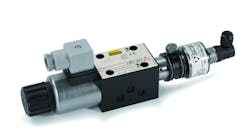These safety valves feature electric on-off monitoring of the spool or poppet position and are TÜV certified according to the safety requirements of Machine Directive 2006/42/EC. They come in two modes: FV has inductive position switch and double contact (NO and NC), and FI has inductive proximity sensor and NO or NC contact. The complete range of safety valves includes directional control valves (sizes 6 to 25, with single and double solenoids), ISO 7368 cartridge valves (standard and active execution, sizes 16 to 100), and ISO 17209 screw-in cartridge valves (sizes ¾-in., 16UNF to 15/16-in., 12UNF). Maximum pressure is 350 bar, and max flow is 5000 l/min.
Atos SpA, [email protected], www.atos.com

